#GPS Tracking Software Development
Explore tagged Tumblr posts
Text
#GPS Tracking Software Development Company#GPS Tracking Software Development Services#GPS Tracking Software Development#Custom GPS Tracking App Development#Custom GPS Software Development
0 notes
Text

Launch your own Uber-like app with advanced features including real-time GPS tracking, driver and passenger management, in-app payments, and seamless ride scheduling. CQLsys Technologies provides both custom-built and white-label mobility solutions designed specifically for the Dubai market — fast, scalable, and fully RTA-compliant.
#Launch Uber clone app with GPS tracking in Dubai#On-demand taxi app development Dubai#Real-time ride booking app for Dubai market#Dubai-based taxi app with in-app payments#Scalable taxi app development with RTA compliance#Mobility app development company Dubai#Driver and passenger management app solution Dubai#Build custom Uber clone app for Dubai startups#White label ride sharing software solution Dubai#Custom-built ride-hailing platform for Dubai transportation
1 note
·
View note
Text
UBITracer Smart Tracking Device: Pinpoint Your Location with Triple Accuracy
1. WiFi Location with UBITracer Tracking Device: Your Urban Navigator 🌆
When surrounded by towering skyscrapers or navigating narrow streets, traditional GPS often struggles. That’s where WiFi location shines.
Benefits: Ultra-precise in urban areas, pinpointing locations with remarkable accuracy.
Use Case: Imagine delivering goods in a crowded city. WiFi location ensures your driver can identify specific buildings or businesses, even in GPS shadow zones.
2. GPS: Precision in Open Spaces 🌄
For wide-open areas like highways, rural roads, or warehouses, GPS is unbeatable.
Accuracy: Within 8 meters, smaller than the size of a standard shipping container!
Use Case: From farm fields to container yards, GPS keeps your operations running smoothly and ensures your assets are always trackable.
3. GSM Location: Always Connected, Even Off the Grid 📶
When WiFi and GPS are unavailable — think mountains, deserts, or dense forests — GSM (cellular signal) steps in as the ultimate fallback.
Reliability: Provides approximate location even in the most remote regions.
Use Case: Ideal for supply chain logistics or emergency response teams operating in challenging environments.
Seamless Switching for Uninterrupted Accuracy 🔄 Hardware
What sets UBITracer apart is its automatic switching capability. The device intelligently chooses the most effective method in real time, ensuring uninterrupted tracking accuracy regardless of your surroundings.
More Than Just Location Tracking Usages
UBITracer isn’t just about knowing where your assets are — it’s about understanding their condition too. Our Multi-Sensor GPS collects and transmits crucial data, including:
Temperature
Humidity
Acceleration
Pressure
Door Openings
This holistic approach empowers supply chain managers to monitor asset health while tracking their location.
Why Businesses Love UBITracer Quality & Security
Our clients use UBITracer to:
Ensure perishable goods stay within safe temperature ranges.
Monitor potential damage during transport through acceleration data.
Verify door openings to prevent theft or tampering.
Explore more real-world use cases at www.ubitracer.com.
Special Offer: Try UBITracer for FREE!
We’re so confident in the value of UBITracer that we’re offering a limited-time free device, along with free cellular data and access to our IoT software platform.
Here’s how to claim:
Purchase a UBITracer Multi-Sensor GPS on Amazon:
Multi-Sensor GPS — Ideal for Valuables ZS-300L
Long-Life Tracker for Temperature Monitoring ZT-28E
Send your Amazon order number and device serial number to [email protected].
Enjoy complimentary cellular data and free platform usage.
For a limited time, receive a full refund through Amazon, making this a risk-free opportunity!
Act Fast — Supplies Are Limited!
Take your IoT journey to the next level with UBITracer. Contact [email protected] today, and let us help you transform how you track and manage your assets.
Stay confident. Stay connected. 🧭
#gps tracker#iotsolutions#logistics#software#gps device#gps and navigation#iot platform#iot development services#innovation#iot applications#iot#technologynews#industrial#tracking#application#apps#supplychainsolutions#supply chain management#supply chain optimization#supplychainlogistics#supplychaininnovation#warehouse#cybersecurity
1 note
·
View note
Text
https://www.bayiotsystems.com
#gps#gps fleet tracking software uae#iot#iot app development#iot applications#iot development services#iot tech#iot platform#iotsolutions#gps fleet tracking kochi
1 note
·
View note
Text
How To Choose Best GPS Tracking Software Development Company
In today's dynamic business landscape, having the Best GPS Tracking Software Development Company by your side can make all the difference. Whether you're in logistics, transportation, or any other industry requiring location-based solutions, finding the right partner is crucial. Plassey Technologies understands the significance of this decision and offers insights into selecting the ideal provider.

1. Key Factors to Consider When Choosing a GPS Tracking Software Development Company
When embarking on your search for the Best GPS Tracking Software Development Company, what factors should you prioritize? Reliability, reputation, and experience rise to the top of the list. Plassey Technologies emphasizes these aspects, ensuring a solid foundation for your partnership.
2. Evaluating Reputation and Reliability
How can you ascertain the reputation and reliability of potential partners? Plassey Technologies suggests delving into online reviews, testimonials, and references. Our track record speaks volumes, backed by satisfied clients who attest to our reliability.
3. Essential Features to Look For
What features should you seek in the Best GPS Tracking Software Development Company? Real-time tracking, robust reporting, customizable alerts – these are just a few functionalities Plassey Technologies integrates seamlessly into its solutions.
4. Comparing Pricing and Packages
How do you navigate the maze of pricing and packages offered by various providers? Plassey Technologies advises looking beyond the numbers to consider scalability and additional services. Our transparent pricing ensures you get the best value for your investment.
5. Reviews and Testimonials
Why are reviews and testimonials vital in the decision-making process? Plassey Technologies understands the power of social proof and encourages prospective clients to explore our satisfied customer base. Their feedback underscores our commitment to excellence.
6. Customization and Scalability
In a competitive market, how important is customization and scalability? Plassey Technologies recognizes that one size does not fit all. Our solutions are tailored to your specific needs, with scalability built-in to accommodate future growth.
7. Past Projects and Examples
What insights can you gain from reviewing past projects? Plassey Technologies invites you to explore our portfolio, showcasing successful implementations across diverse industries. These examples illustrate our expertise and innovative approach.
8. Customer Support and Maintenance
How crucial is customer support and maintenance in the long run? Plassey Technologies places a premium on client satisfaction, offering unparalleled support and proactive maintenance services. Our dedicated team ensures your operations run smoothly, day in and day out.
9. Industry Certifications and Qualifications
Are there certifications and qualifications that distinguish the Best GPS Tracking Software Development Company? Plassey Technologies holds industry certifications and boasts a team of qualified experts. You can trust us to deliver cutting-edge solutions that meet regulatory standards and exceed expectations.
10. Security Measures
What measures should a Best GPS Tracking Software Development Company implement to safeguard your data? Plassey Technologies prioritizes data security, employing robust encryption and stringent access controls. Rest assured, your sensitive information is in safe hands.
Conclusion:
Choosing the Best GPS Tracking Software Development Company is a critical decision that requires careful consideration. Plassey Technologies stands ready to be your trusted partner, offering unparalleled expertise, innovative solutions, and unwavering support. Contact us today to embark on a journey towards success.
0 notes
Text
Best Trucking Dispatch Software Solutions
TruckLogics is a trucking dispatch software for logistics for small and medium-sized full truckload (FTL) and less-than-truckload companies.TruckLogics offers traditional fleet management services such as dispatch, route optimization, dispatch, shipping brokerage, and pricing. In addition, it offers load optimization, compliance management, quote management, and fleet maintenance.TruckLogics includes fuel accounting, barcoding, inventory tracking modules, and international shipping assistance. In addition, TruckLogics users can keep track of vehicle history and fuel consumption.TruckLogics, a cloud-based software system, works on both Mac and Windows. In addition, it can be accessed from both Android and iOS smartphones. This allows users to access their business activities anywhere.
Visit us:
#Best Trucking Software#Best Trucking Dispatch Software#gps tracking device#blockchain application development#Trucking Dispatch Software
0 notes
Note
After seeing your weatherbugapp reblog i installed duckduckgo and tried it.

I don't know much about technology tbh but i downloaded this app less than 30 mins ago and in that time google tried to track me 112 times?? And they tried to collect finger prints? And my first and last name? And my gender? And my country, state and city? My gps coordinates? My postal code? My network carrier? My fricking battery level for whatever reason? Can you please tell me if this is normal at all, because i'm freaking out right now. I just turned 18 and started using mobile banking and stuff and this shit scares me
Why tf does it need to know my screen density???my system volume????my charging status????? What tf are they cooking
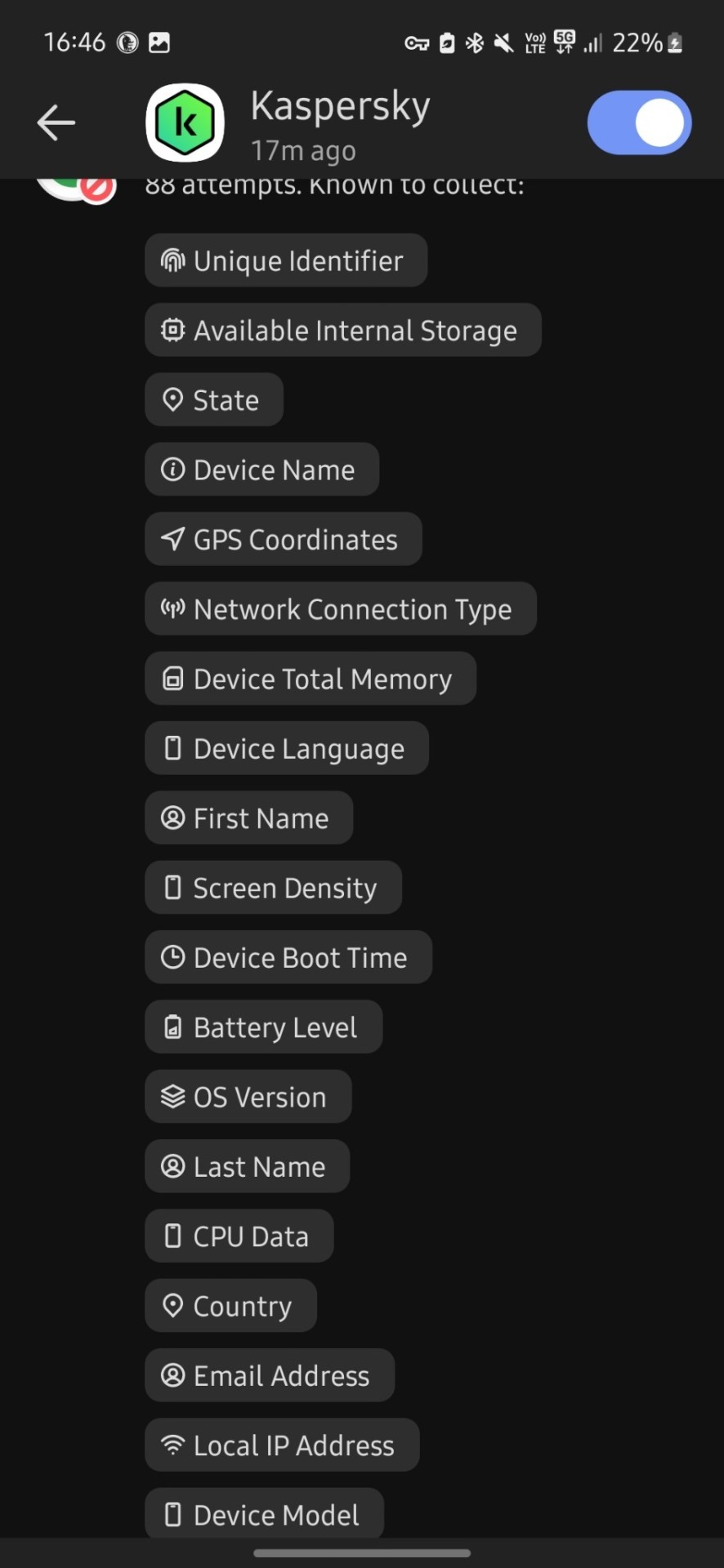
Now it's at 476 tracking attempts bro???? barely 5 mins passed.....
I condensed your three asks into one for readability!
And yeah, I'm very far from an expert about any of this, but as far as I know that's just. Normal. That's the normal amount of spying they're doing on your phone. I assume the numbers we see are to some extent because having been foiled, a lot of these scripts try repeatedly, since I can't imagine what use thousands of trackers per phone would be even to the great aggregators.
Tracking the phone stuff like screen resolution and battery level is because (apart from that definitely not being considered remotely 'private' so it's Free Real Estate) in aggregate that data can be used to track what phone use patterns are like on a demographic scale and therefore. Where the smart money is.
Almost all of this is getting sold in bulk for ad targeting and market analysis. This does presumably make it very hard to notice when like. Actually important stuff is being spied on, which is why I feel better about Having Apps with the duckduckgo app blocker thing.
My bank's app reportedly sells data to a couple aggregators including Google. Not like, my banking info, but it's still so offensive on principle that I avoid using the app unless I have to, and force stop it afterward.
The patterns that show up on the weekly duckduckgo blocker report are interesting. Hoopla attempts about two orders of magnitude more tracking than Libby, which makes sense because they're a commercial streaming service libraries pay by the unit for access, while Libby is a content management software run by a corporation that values its certification as a 'B' company--that is, one invested in the public good that can be trusted. The cleanness of their brand is a great deal of its value, so they have to care about their image and be a little more scrupulous.
Which doesn't mean not being a little bit spyware, because everything is spyware now. Something else I've noticed is that in terms of free game apps, the polished professional stuff is now much more invasive than the random kinda janky thing someone just threw together.
Back in the day you tended to expect the opposite, because spyware was a marginal shifty profit-margin with too narrow a revenue stream to be worth more to an established brand than their reputation, but now that everyone does it there's not a lot of reputation cost and refraining would be sacrificing a potential revenue stream, which is Irresponsible Conduct for a corporation.
While meanwhile 'developing a free game app to put on the game store' is something a person can do for free with the hardware they already have for home use, as a hobby or practice or to put on their coding resume. So while such apps absolutely can be malicious and more dangerous when they are than The Big Brand, they can also be neutral in a way commercial stuff no longer is. Wild world.
But yeah for the most part as far as I can make out, these are just The Commercial Panopticon, operating as intended. It's gross but it probably doesn't indicate anything dangerous on an individual level.
56 notes
·
View notes
Text
Feeling like putting down my find so here is
JV/Ant Davidson Timeline
(Can’t guarantee 100% accuracy on all info, can’t guarantee no bias no projection, not using there full names because guess what, so less info about them together if you google their names together my blog appears on the 1st page)
JV was raised in Switzerland. Did math and computer science in Switzerland. He found out he needed an engineer background to enter F1 so went back to England to get a master in that. Got to work at BAR(later Honda, Brawn, Merc) eventually. (He had a billion interview on him hustling his way to BAR but that’s not relevant to the story here)
Ant was raised in a middle class family. Went to Karting with brother and he was more interested and started to compete in Karting. He worked his way to Formula Ford and was lucky to get a sponsorship( the sponsor bought a house and let him lived there). His sponsor talked to him about career choice, at that time, test driver made a decent amount of money and that f1 seat seems a bit too distant. So Ant ended up in BAR around the same time as JV
Well JV was not that much of an engineering guy. His job going into Honda was a combination of some data analysis, coordination between departments and some engineer. There was no proper strategist job back in the days so he just bounced around. (The untold interview he said he was suppose to fix an electronic problem on the front wing, Evan Short ended up doing that. Not saying that he knew nothing but inferring from his other interview, he definitely needed help). (Even now strategist have “low” status in the team since only the principal strategist can go to the track and everyone back home’s job is make sure to feed enough info through TR that the principal’s eyes are always on track).
Meanwhile, Ant was doing amazing as a test driver, too amazing that Honda was reluctant to release him to do actual f1 racing. He missed a seat(which team I forgot) but Honda eventually agreed to let him race for Super Aguri in 2007. That team didn’t last.
Then came the Brawn year. Before 2009, JV and Ant were already starting to worry about their jobs and registered a company together. Company never took off because here comes Brawn GP.
After the championship, our champ Jenson was scheduled to do victory laps in the factory for the fans but he already buggered off to McLaren. Ant did the laps and JV was his engineer for that.
Then came the Merc years.
Ant was doing a bunch of different things then: racing in WEC, driving the Merc simulator and later became a sky sport host. Ant missed the chance of winning a championship(he also missed a podium due to bad luck in 2007) but he got one eventually. When Alonso returned to F1, Ant interviewed him asking if Alonso remembered them racing against each other in WEC, Alonso did not remember. Ant also did Jenson’s retirement interview. Ant also did some interview later saying he was too nice to be competing in this shark tank of f1, nice guy can’t win races.
JV was doing a bunch of different things in Merc as well. He was in charge of simulator, junior team, esport team and development data analysis software for premier league(honorable mention: he wrote the drivers code of conduct in 2016 to prevent Lewis and Nico fighting). Ant was a reliable simulator driver, JV was working a lot with Ant at that time(JV didn’t need to be present for the crowd strike thing but he was there…) (Also they Merc’s equipment to tune cars for their friend’s Karting league, naughty boys). I want to believe JV cares about drivers he works with, especially junior team (he went up to hug Esteban Ocon(Merc junior driver) after his 2021 Hungarian gp win(Merc strategy was a disaster that race)
Ant said JV is one of his best friends. He phoned JV a lot during the Honda and Brawn years. Ant also texted JV to ask for technical details when he started to comment for Sky( Ant joked in 2023 pre season test that JV is getting to busy with his TP job to reply to his texts). JV also bugged Ant for a VIP pass during Ant’s LeMans years. JV had spent time with Ant’s family doing barbecue for JV’s birthday. JV is Ant’s kids’ god father.
Projection time: Brawn and Merc years treated JV so well he probably is a bit idealist about things now. The stuff he said at Williams make sense if your work experience is a streak of championships. JV will probably never get a reality check so hard the way Ant exit F1(divorce? Idw). Knowing they are good friends make me happy.
(Some source from Ant’s deleted twitter account)
22 notes
·
View notes
Text
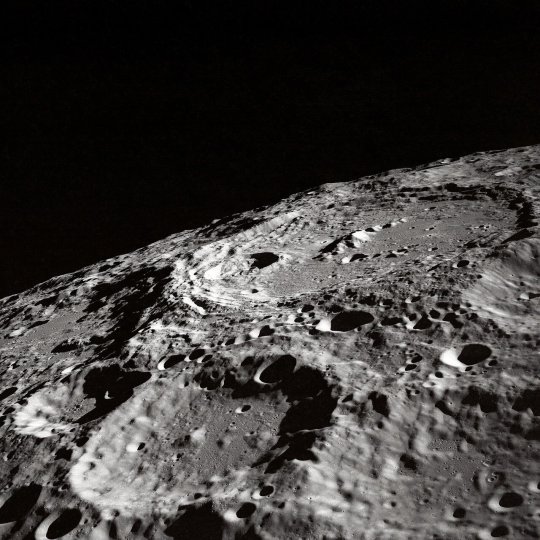
NASA and Italian Space Agency test future lunar navigation technology
As the Artemis campaign leads humanity to the moon and eventually Mars, NASA is refining its state-of-the-art navigation and positioning technologies to guide a new era of lunar exploration.
A technology demonstration helping pave the way for these developments is the Lunar GNSS Receiver Experiment (LuGRE) payload, a joint effort between NASA and the Italian Space Agency to demonstrate the viability of using existing GNSS (Global Navigation Satellite System) signals for positioning, navigation, and timing on the moon.
During its voyage on an upcoming delivery to the moon as part of NASA's CLPS (Commercial Lunar Payload Services) initiative, LuGRE would demonstrate acquiring and tracking signals from both the U.S. GPS and European Union Galileo GNSS constellations during transit to the moon, during lunar orbit, and finally for up to two weeks on the lunar surface itself.
The LuGRE payload is one of the first demonstrations of GNSS signal reception and navigation on and around the lunar surface, an important milestone for how lunar missions will access navigation and positioning technology.
If successful, LuGRE would demonstrate that spacecraft can use signals from existing GNSS satellites at lunar distances, reducing their reliance on ground-based stations on the Earth for lunar navigation.
Today, GNSS constellations support essential services like navigation, banking, power grid synchronization, cellular networks, and telecommunications. Near-Earth space missions use these signals in flight to determine critical operational information like location, velocity, and time.
NASA and the Italian Space Agency want to expand the boundaries of GNSS use cases. In 2019, the Magnetospheric Multiscale (MMS) mission broke the world record for farthest GPS signal acquisition 116,300 miles from the Earth's surface—nearly half of the 238,900 miles between Earth and the moon. Now, LuGRE could double that distance.
"GPS makes our lives safer and more viable here on Earth," said Kevin Coggins, NASA deputy associate administrator and SCaN (Space Communications and Navigation) Program manager at NASA Headquarters in Washington. "As we seek to extend humanity beyond our home planet, LuGRE should confirm that this extraordinary technology can do the same for us on the moon."
Reliable space communication and navigation systems play a vital role in all NASA missions, providing crucial connections from space to Earth for crewed and uncrewed missions alike. Using a blend of government and commercial assets, NASA's Near Space and Deep Space Networks support science, technology demonstrations, and human spaceflight missions across the solar system.
"This mission is more than a technological milestone," said Joel Parker, policy lead for positioning, navigation, and timing at NASA's Goddard Space Flight Center in Greenbelt, Maryland.
"We want to enable more and better missions to the moon for the benefit of everyone, and we want to do it together with our international partners."
The data-gathering LuGRE payload combines NASA-led systems engineering and mission management with receiver software and hardware developed by the Italian Space Agency and their industry partner Qascom—the first Italian-built hardware to operate on the lunar surface.
Any data LuGRE collects is intended to open the door for use of GNSS to all lunar missions, not just those by NASA or the Italian Space Agency. Approximately six months after LuGRE completes its operations, the agencies will release its mission data to broaden public and commercial access to lunar GNSS research.
"A project like LuGRE isn't about NASA alone," said NASA Goddard navigation and mission design engineer Lauren Konitzer. "It's something we're doing for the benefit of humanity. We're working to prove that lunar GNSS can work, and we're sharing our discoveries with the world."
The LuGRE payload is one of 10 science experiments launching to the lunar surface on this delivery through NASA's CLPS initiative.
Through CLPS, NASA works with American companies to provide delivery and quantity contracts for commercial deliveries to further lunar exploration and the development of a sustainable lunar economy. As of 2024, the agency has 14 private partners on contract for current and future CLPS missions.
Demonstrations like LuGRE could lay the groundwork for GNSS-based navigation systems on the lunar surface. Bridging these existing systems with emerging lunar-specific navigation solutions has the potential to define how all spacecraft navigate lunar terrain in the Artemis era.
The payload is a collaborative effort between NASA's Goddard Space Flight Center and the Italian Space Agency.
8 notes
·
View notes
Text
Day 2 at iSarva: Help Me Help You (Before My Boss Finds Out 😅)”If You Need Website, I’ll help you out

Hi there, I’m Thea – a Marketing Intern at iSarva Infotech Pvt. Ltd., and it’s only my second day on the job (yes, you read that right – day two!). While I’m still soaking in all the tech wizardry around me, my boss already gave me my first mission:
👉 Find people who need websites, apps, or any digital solution. If I don’t… well, let’s just say I’ll be in trouble 😅
🧠 So What Does iSarva Infotech Even Do?
We’re an IT software company based in India that builds and supports everything digital — From simple, elegant websites to complex enterprise-level software. Here’s a taste of what we do:
✨ Web Development – Clean, fast, mobile-friendly websites that actually work. ⚙️ ERP Solutions – Customized systems to simplify your operations. 🚀 Digital Marketing – Because just existing online isn’t enough. 🛰️ Cloud Services – Modern, scalable, and reliable. 🧭 GPS Tracking Software – Track, manage, and optimize on the go. 🌍 Offshore Development – Hire dedicated developers, without boundaries.
👀 Who Can We Help?
Small business owners 🧑💼
Entrepreneurs with a big vision 💡
Corporates with outdated tech 🏢
Startups who want to move fast 🚀
Anyone who wants to go digital in 2025
📣 Now Here's My Pitch
If you or someone you know needs a website, app, digital marketing, ERP, or software that doesn’t suck... 👉 Please DM me +91 99028 63697 I’ll connect you with the team (and maybe avoid the wrath of my boss 😬).
Check out our work here: https://isarvait.com
Let’s build something cool together. Your idea + Our tech = 🔥
—
#marketingintern #isarvainfotech #websitedesign #digitalagency #startuptech #internshipdiaries #indianstartup #ITsolutions #supportsmallbusiness #letsconnect
#uiux#website#web development#website design#hrms software#wordpress#weirdcore#ecommerce#software#technology#digital transformation#smart tech#computer#cell phones#laptops#technoblade#techinnovation#technique#tech#phones
2 notes
·
View notes
Text
The Future Of Kids Smartwatches: What To Expect In The Next Five Years.
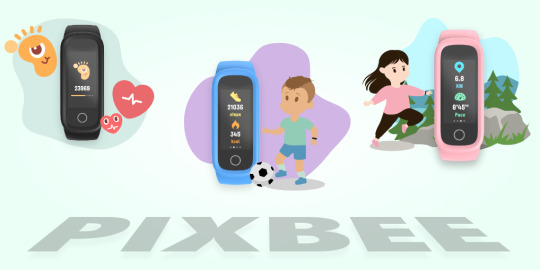
Today's children are growing up in a world dominated by technology. From smartphones and tablets to smart home devices, technology is becoming an integral part of their lives. As parents, it is natural for us to want to keep an eye on our children's activities, and that's where kids smart watches come in. These wearable devices are specifically designed for children and offer a range of features to keep them safe and entertained. In this article, we will explore the future of kids smartwatches and what we can expect in the next five years.
Future trends in children's smartwatches
In the coming years, kids smartwatches are expected to witness several trends that will enhance their functionality while addressing the concerns of parents. Let's take a closer look at some of these exciting trends:
1. Safety
Safety has always been the primary concern for parents when it comes to their children. In the future, kids smartwatches are likely to incorporate advanced GPS tracking technology to provide real-time location monitoring. Parents will be able to track their children's whereabouts and set up safe zones, and receive notifications whenever their child leaves or enters a designated area. This feature will bring parents peace of mind, especially when their children are away from home, ensuring their safety at all times.
2. Health and Fitness Tracking
In an era where childhood obesity is a growing concern, kids smartwatches will play a crucial role in promoting fitness among children. Future wearables will feature enhanced Fitness tracking capabilities, such as heart rate monitoring, step counting, and sleep tracking. These features will enable parents to monitor their child's activity levels, encourage them to lead an active lifestyle, and ensure they are getting enough rest.
3. Educational Features
Kids smartwatches are not just limited to safety and fitness tracking. They are also excellent learning tools for children. In the next five years, we can expect to see more educational features incorporated into these devices. This could include interactive games, language learning apps, and even augmented reality experiences. These features will make learning fun and engaging for children, helping them develop essential skills while keeping them entertained.
4. Two-Way Communication
Communication is an essential aspect of any smartwatch, and kids' wearables are no exception. In the future, kids smartwatches will likely offer advanced two-way communication capabilities. Parents will be able to call or message their child directly from their smartphone, and vice versa. This feature will ensure that parents can stay connected with their children at all times, even when they are apart. It will also allow children to reach out to their parents in case of an emergency or any other concerns.
5. Customization
Children love expressing their individuality, and customizability will be a significant trend in kids smartwatches. In the future, these wearables will come in various colors, patterns, and designs to cater to different personalities and preferences. Kids will have the option to choose their favorite themes or characters, making their smartwatch truly their own.
Also Read: [Teaching Safety and Responsibility through Kids Smart Watches.]
Technological advancements in kids wearables
As technology continues to evolve rapidly, kids smartwatches will also witness significant advancements in terms of hardware and software. Let's explore some of the technological advancements we can expect in the next few years:
1. More Powerful Processors
As kids smartwatches become more sophisticated, they will require more powerful processors to handle complex tasks and deliver a seamless user experience. The future smartwatches for children will feature faster processors, enabling smooth multitasking and better performance.
2. Longer Battery Life
Battery life is always a concern when it comes to wearable devices. In the future, kids smartwatches will be equipped with more advanced battery technology, allowing them to last longer on a single charge. This will ensure that children can use their smartwatches throughout the day without worrying about running out of battery.
3. Improved Durability
Children can be rough with their toys and gadgets, so durability is a crucial factor to consider in kids smartwatches. In the coming years, we can expect these wearables to become even more rugged and resistant to water, dust, and accidental drops. This will make them more suitable for active and adventurous kids.
4. Enhanced User Interface
The user interface of kids smartwatches will also undergo significant improvements in the future. They will feature more intuitive touchscreens, voice recognition capabilities, and gesture-based controls, making it easier for children to navigate and interact with their smartwatches.
5. Integration with Other Devices
In the next five years, kids smartwatches will become more integrated with other devices and smart home ecosystems. They will be able to connect with smartphones, tablets, and even smart home devices, allowing parents to monitor and control various aspects of their child's environment through a single interface.
As we look to the future of kids smartwatches, it's evident that these wearable devices will continue to evolve and adapt to meet the needs of both parents and children. With advanced safety features, educational capabilities, and technological advancements, the next five years hold immense potential for kids wearables. Parents can look forward to enhanced peace of mind, while children can enjoy a fun and engaging experience with their smartwatches. So, buckle up and get ready for the exciting future of kids smartwatches!
20 notes
·
View notes
Text
GIS In Our Daily Lives
The involvement of Geographic Information Systems (GIS) in our daily lives is pervasive, influencing and enhancing various aspects across different sectors. The integration of GIS into everyday activities has become integral for decision-making, planning, and optimizing resources. GIS helps city planners and transportation experts to provide them with information like maps, satellite pictures, population statistics, and infrastructure data. GIS helps them make better decisions when designing cities and transportation systems that are sustainable and good for the environment.
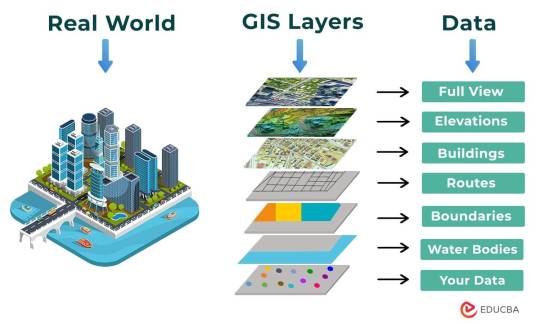
The following points elucidate the notable involvement of GIS in our daily lives:
Navigation and Location Services: GIS provides monitoring functions through the visual display of spatial data and precise geographical positioning of monitored vehicles, whereas GPS provides accurate, clear, and precise information on the position and navigation of a monitored or tracked vehicle in real-time and at the exact location.GIS is at the core of navigation applications and location-based services on smartphones. It enables accurate mapping, real-time navigation, and geolocation services, assisting individuals in finding locations, planning routes, and navigating unfamiliar areas.
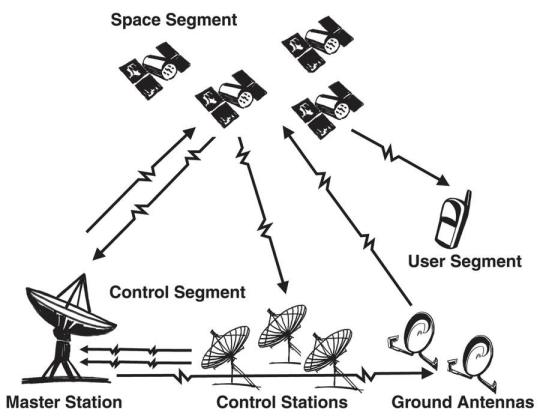
E-Commerce and Delivery Services: GIS software is a powerful tool for supply chain network planning. It helps determine the optimal location for distribution centers, warehouses, or other supply facilities. GIS is utilized in logistics and delivery services for optimizing routes, tracking shipments, and ensuring timely deliveries. E-commerce platforms leverage GIS to enhance the efficiency of their supply chain and last-mile delivery processes.
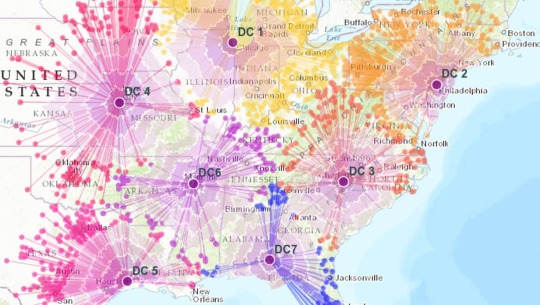
Weather Forecasting and Disaster Management: Many states are using GIS dashboard to monitor the rainfall across the state, on a real-time basis, from the data shared by rain sensors installed at various locationsGIS plays a crucial role in weather forecasting and disaster management. It assists meteorologists in analyzing spatial data, predicting weather patterns, and facilitating timely responses to natural disasters by mapping affected areas and coordinating emergency services.
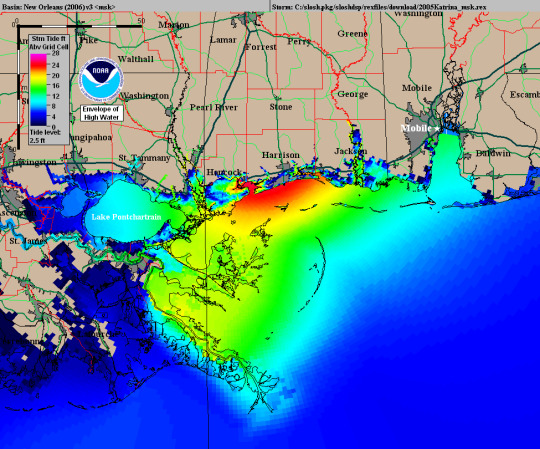
Healthcare Planning and Disease Monitoring: Geographic Information Systems enable the visualization and monitoring of infectious diseases. Additionally GIS records and displays the necessary information that health care needs of the community as well as the available resources and materials. GIS supports public health initiatives by mapping the spread of diseases, analyzing healthcare resource distribution, and assisting in the planning of vaccination campaigns. It aids in identifying high-risk areas and optimizing healthcare service delivery.
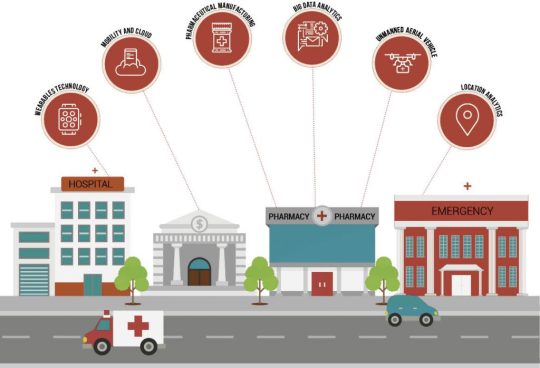
Social Media and Geo-tagging: GIS also helps in geotagging and other location related information in posts, it’s tools can map and visualize the spatial distribution of social media activity. This analysis can reveal trends, hotspots, and patterns in user engagement across different geographic areas. Many social media platforms incorporate GIS for geo-tagging, allowing users to share their location and experiences. This feature enhances social connectivity and facilitates the sharing of location-specific information.
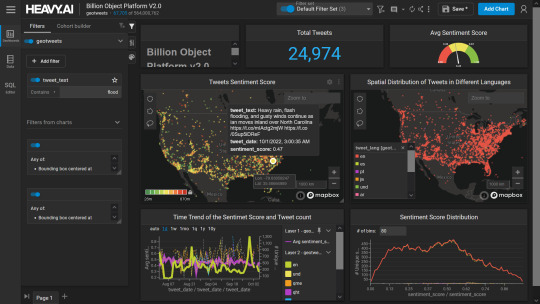
Smart City Initiatives: The Geographic Information System (GIS) offers advanced and user-friendly capabilities for Smart City projects and allows to capture, store and manipulate, analyze and visualize spatially referenced data. It is used for spatial analysis and modeling. It is the cornerstone of smart city planning, enabling the integration of data for efficient urban management. It supports initiatives related to traffic management, waste disposal, energy consumption, and overall infrastructure development.
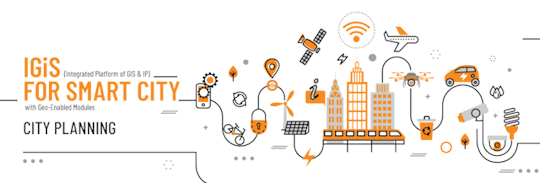
Education and Research: GIS is increasingly utilized in education and research for visualizing and analyzing spatial data. It enables students and researchers to explore geographic relationships, conduct field studies, and enhance their understanding of various subjects.

Agricultural Management and Precision Farming: Farmers leverage GIS to optimize agricultural practices by analyzing soil conditions, crop health, and weather patterns. Precision farming techniques, facilitated by GIS, contribute to increased crop yields and sustainable farming practices.
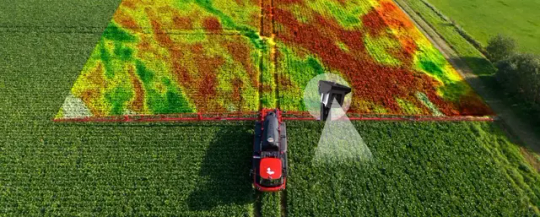
Real Estate and Property Management: In the real estate sector, GIS aids in property mapping, land valuation, and site selection. It provides real estate professionals with valuable insights into spatial relationships, market trends, and optimal development opportunities.
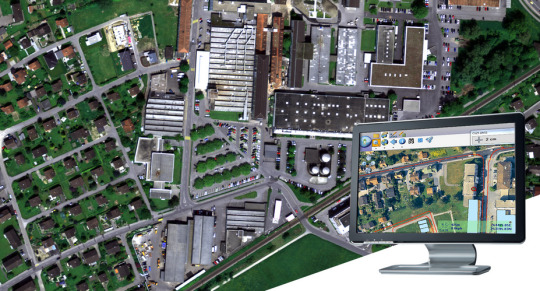
Tourism and Recreation: GIS enhances the tourism industry by providing interactive maps, route planning, and location-based information. It assists tourists in exploring destinations, finding attractions, and navigating efficiently.
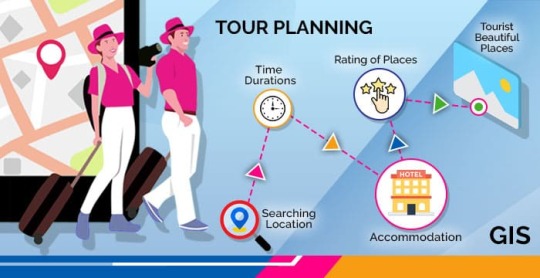
The broad and varied involvement of GIS in our daily lives underscores its significance as a technology that not only facilitates geographic data analysis but also contributes to the efficiency, safety, and interconnectedness of modern society. As GIS applications continue to evolve, their impact on daily activities is expected to further expand and refine.
#gis#architectdesign#architecture#city#education#geographic information system(gis)#geographical indication
14 notes
·
View notes
Text
As a trucker, you can perform various tasks within truck dispatching:
*Primary Responsibilities:*
1. Receive and accept load assignments from dispatchers.
2. Review load details, routes, and schedules.
3. Plan and navigate routes using GPS and maps.
4. Manage cargo, including loading/unloading and securement.
5. Comply with safety regulations, hours of service, and company policies.
6. Communicate with dispatchers, shippers, and receivers.
7. Update dispatchers on shipment status and any issues.
*Additional Tasks:*
1. Pre-trip inspections: ensure vehicle safety and compliance.
2. Fuel management: optimize fuel efficiency and costs.
3. Maintenance scheduling: coordinate vehicle maintenance.
4. Logkeeping: maintain accurate records of hours, miles, and cargo.
5. Customer service: interact with shippers, receivers, and brokers.
6. Route optimization: suggest alternative routes or improvements.
7. Load optimization: maximize cargo capacity and revenue.
*Technology Used:*
1. Electronic Logging Devices (ELDs)
2. GPS tracking systems
3. Mobile apps (e.g., Trucker Path, TruckStop)
4. Fleet management software (e.g., TMW, McLeod)
5. Communication platforms (e.g., phone, email, messaging apps)
*Skills Required:*
1. Knowledge of transportation regulations
2. Navigation and route-planning skills
3. Time management and organization
4. Communication and customer service skills
5. Mechanical knowledge of trucks and equipment
6. Adaptability and problem-solving
7. Attention to detail and safety protocols
*Career Advancements:*
1. Lead driver or mentor
2. Fleet manager
3. Safety inspector
4. Dispatch coordinator
5. Logistics manager
6. Owner-operator or small fleet owner
7. Transportation consultant
*Benefits:*
1. Competitive pay and benefits
2. Job security and stability
3. Opportunities for advancement
4. Independence on the road
5. Variety in routes and cargo
6. Sense of accomplishment and satisfaction
Would you like more information on:
1. Trucking regulations
2. Dispatching software
3. Career development
4. Safety protocols
5. Something else
Let me know!
2 notes
·
View notes
Text
Key Features & Technologies for On-Demand App Development Success
Introduction to On-Demand App Development
On-demand apps have transformed the way businesses offer services and products to customers. With the ability to request services at any time, on-demand apps have become an essential part of daily life, spanning industries like healthcare, transportation, and food delivery. In this blog, we will discuss the key features, technologies, and best practices for on-demand app development to ensure success in this competitive space.
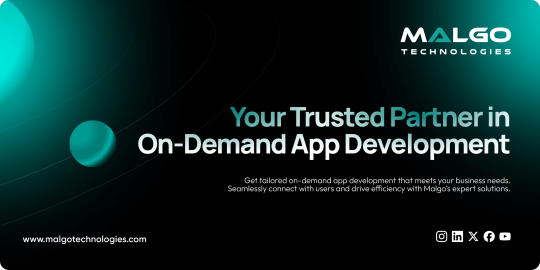
What is On-Demand Application Development?
On-demand app development refers to the creation of apps that provide users with services or products instantly or at their convenience. The primary goal is to offer real-time solutions, ensuring that customers can access services as soon as they need them. From food delivery to ride-hailing, on-demand apps have revolutionized many industries, creating more convenient and seamless experiences for users.
How On-Demand Apps are Reshaping Various Industries
On-demand apps are changing the way industries function by making services more accessible. Whether it’s through easier access to healthcare, food, or transportation, on-demand solutions offer a higher level of convenience and satisfaction for customers. This shift is not only benefiting consumers but is also helping businesses expand their reach and improve efficiency.
What is App Development?
App development is the process of creating software applications that run on mobile devices or computers. These applications are developed to provide specific solutions to users' needs, whether it's an app for shopping, entertainment, or managing tasks. For on-demand apps, the focus is on providing instant access to services and an enhanced user experience.
What is On-Demand App Development?
On-demand app development involves building apps that deliver services or products immediately, on request, or according to user preferences. These apps typically feature a seamless interface, real-time tracking, secure payment systems, and customer support, making them the go-to solution for businesses wanting to engage with users in a more responsive and efficient manner.
What is Mobile App Development?
Mobile app development focuses on creating software applications for mobile devices such as smartphones and tablets. Mobile app development for on-demand services emphasizes user experience, speed, security, and scalability, ensuring that users can access services anytime and anywhere with ease.
Why On-Demand App Development is Important for Business
Enhanced Customer Experience: Provides instant service accessibility, boosting customer satisfaction.
Increased Revenue Streams: Helps businesses reach a wider audience and generate higher profits.
Improved Brand Loyalty: A well-optimized app enhances user engagement and customer retention.
Key Features for Successful On-Demand Mobile App Development
Seamless User Interface: An intuitive design with easy navigation ensures a smooth user experience.
Real-Time Tracking & Notifications: Users can track their orders or services in real-time and receive instant notifications.
Secure Payment Gateway Integration: Multiple payment options and secure transaction methods build customer trust.
Multi-Platform Compatibility: Ensures the app runs smoothly on both iOS and Android platforms.
Latest Technologies Driving On-Demand App Development
AI & Machine Learning Integration: Offers personalized recommendations and predictive analytics.
Cloud-Based Infrastructure: Provides scalability and secure data storage.
GPS & Geolocation Services: Enables accurate tracking and efficient route optimization.
Blockchain for Secure Transactions: Ensures transparency and reduces the risk of fraud.
Industry-Specific On-Demand App Solutions
On-Demand Home Services App Development: Allows users to book cleaning, plumbing, or repair services with ease.
Doctor On-Demand App Development: Enables virtual consultations and appointment scheduling.
Food Delivery & Taxi Booking Solutions: Provides real-time order tracking and instant booking options.
How to Choose the Best On-Demand App Development Company
Expertise of On-Demand App Developers
A skilled team with experience in building feature-rich and scalable on-demand apps is essential for success.
Custom On-Demand Application Development Services
Tailored solutions that align with business goals and user preferences.
Cost-Effective Solutions by On-Demand Mobile App Development Company
Malgo stands out for offering flexible and budget-friendly on-demand app development without compromising performance.
Cost Estimation & Development Timeline
Factors Affecting On-Demand App Development Cost
The development cost depends on factors such as feature complexity, technology stack, customization requirements, and deployment preferences. Get in touch with Malgo for a detailed quote.
Estimated Time for Different Features & Technologies
Basic features like user registration and payment integration: 3-6 months
Advanced features like AI-based recommendations and GPS tracking: 6-12 months
Complete testing and deployment: 1-2 months
Future Trends in On-Demand App Development
Rise of Web3 in On-Demand Services
Decentralized platforms are set to enhance security, transparency, and user control.
Integration of AR/VR for Enhanced User Experience
Immersive technologies like AR/VR are improving user interaction in industries like real estate and healthcare.
Why Malgo is the Right Choice for On-Demand App Development
Malgo stands out as a top choice for businesses looking for scalable, secure, and high-performance on-demand mobile apps. Their team focuses on delivering custom solutions that meet modern business demands and ensure user satisfaction.
Final Thoughts
On-demand apps are revolutionizing business operations by offering instant services and improving customer satisfaction. Get top-notch On-Demand App Development services from industry experts today!. With the right features and technologies, businesses can enhance user experiences and expand their market reach. Malgo is the perfect partner for building top-notch on-demand apps that drive business growth. Get in touch with them for a detailed quote.
#appdevelopment#techinnovation#mobile app development#app development#ondemandapps#customappdevelopment#mobileappdesign
1 note
·
View note
Text
Build a Turo Clone | Top Features to Include in Your Car Rental App
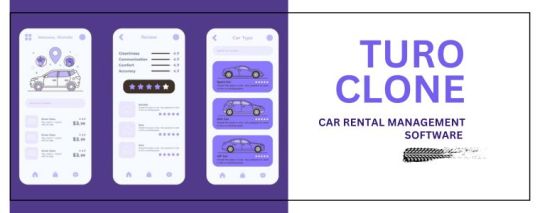
In the age of digital convenience, the car rental industry has undergone a massive transformation. Gone are the days when people had to visit rental agencies physically, fill out lengthy paperwork, and wait for approvals. Today, platforms like Turo have revolutionized car rentals, offering users a seamless way to rent and list vehicles with just a few taps on their smartphones. If you're considering developing a Turo clone, you're on the right path to tapping into the booming car-sharing market. But what does it take to create a car rental app like Turo? Which features make the difference between a mediocre app and a market-leading one?
Let’s dive into the essential aspects of building a Turo-like app, including the core features, development process, and the role of a reliable on-demand app development company in bringing your vision to life.
Why Build a Turo Clone?
The car rental industry is growing exponentially, fueled by increasing demand for flexible and cost-effective mobility solutions. Traditional car rental companies often come with rigid rules and high rental costs, which is why peer-to-peer (P2P) car-sharing platforms like Turo have gained immense popularity.
Here’s why launching a Turo clone is a lucrative idea:
High Market Demand: The demand for car-sharing apps is increasing as users prefer affordable, hassle-free rentals over traditional agencies.
Scalable Business Model: P2P car rentals generate revenue through service fees, subscription models, and add-ons like insurance.
Minimal Inventory Investment: Unlike conventional rental businesses, you don’t need to own a fleet of cars; users list their own vehicles.
Expanding Sharing Economy: As more consumers embrace the sharing economy, launching a Turo-like app is a timely and profitable venture.
But building a car rental management software that replicates Turo’s success is no small feat. It requires careful planning, robust technology, and an intuitive user experience.
Key Features to Include in Your Turo Clone
If you want to create a car rental app like Turo, you need to incorporate features that enhance usability, security, and efficiency. Let’s break down the must-have features:
1. User-Friendly Registration & Profile Management
A smooth onboarding process is crucial. Allow users (both renters and car owners) to sign up using email, phone numbers, or social media accounts. The profile management section should include:
ID verification (driver’s license, passport)
Profile completion status
Rental history
Reviews & ratings
A well-structured car rental management software ensures seamless user interactions from the start.
2. Advanced Search & Filtering Options
A powerful search mechanism is essential for finding the right vehicle quickly. Your app should allow users to filter cars based on:
Vehicle type (sedan, SUV, luxury, electric, etc.)
Rental duration (hourly, daily, weekly)
Pricing range
Location-based availability
AI-powered recommendations can enhance the search experience by suggesting cars based on past preferences.
3. Seamless Booking System
Your Turo clone should offer a frictionless booking experience. Essential aspects include:
Instant booking vs. request-based booking
Flexible pricing options
Secure payment gateway integration
Cancellation policies
Users should be able to reserve a car within seconds, eliminating unnecessary steps in the process.
4. Secure Payment Gateway & Wallet Integration
A robust payment system ensures smooth transactions. Features like:
Credit/debit card payments
PayPal, Stripe, or Apple Pay integration
In-app wallets for faster checkouts
Split payments (for ride-sharing features)
Secure payments build user trust, a critical aspect of any Turo-like app.
5. Real-Time GPS Tracking & Navigation
Live location tracking is essential for both car owners and renters. With integrated GPS tracking, users can:
Find nearby rental vehicles
Get real-time navigation assistance
Monitor the rented car’s location
This enhances security and improves overall service quality.
6. Ratings, Reviews & Feedback System
User-generated ratings and reviews help maintain credibility. A two-way feedback system (where both renters and owners review each other) ensures reliability and trustworthiness.
7. Damage Reporting & Insurance Integration
Unlike traditional rental services, P2P car rentals require robust insurance policies to cover damages. Your car rental management software should include:
Instant damage reporting
Insurance coverage details
Claim processing system
This feature enhances the safety net for both car owners and renters.
8. Push Notifications & Alerts
Timely notifications keep users engaged and informed. These can include:
Booking confirmations & reminders
Payment updates
Special offers & discounts
Vehicle pick-up and drop-off alerts
An AI-driven Turo-like app can personalize notifications based on user activity.
9. Admin Dashboard for Business Insights
A whitelabel property management software or admin panel is necessary for managing the platform. The dashboard should include:
User activity monitoring
Revenue analytics
Dispute resolution system
Customer support module
This ensures smooth platform operations and growth tracking.
The Development Process: How to Build a Turo Clone?
Developing a Turo clone isn’t just about coding an app—it involves strategic planning and execution. Here’s a roadmap to get started:
Step 1: Market Research & Business Model Planning
Analyze competitors like Turo, Getaround, and Zipcar
Decide on your revenue model (commission-based, subscription, etc.)
Identify your target audience
Step 2: Choose the Right Technology Stack
For a scalable, high-performing app, consider:
Backend: Node.js, Python, Ruby on Rails
Frontend: React Native, Flutter
Database: MongoDB, Firebase
Cloud Hosting: AWS, Google Cloud
A reliable on-demand app development company can help you select the best tech stack.
Step 3: UI/UX Design & App Development
A seamless, intuitive interface is key. Your app should offer a smooth booking experience with minimal clicks.
Step 4: Testing & Deployment
Perform rigorous testing for bugs and security loopholes
Launch a beta version for user feedback
Deploy the app across iOS and Android platforms
Why Work with an On-Demand App Development Company?
Building a Turo clone requires expertise in mobile app development, security, and user experience design. Partnering with an on-demand app development company ensures:
Custom development tailored to your business needs
Scalability for future expansion
Seamless API integration (for payments, GPS, insurance, etc.)
Ongoing maintenance and support
A professional team can help you navigate challenges and ensure a successful product launch.
Final Thoughts
Developing a Turo-like app is a profitable venture, provided you focus on user-centric features, seamless transactions, and a scalable business model. By incorporating the right technology and working with a trusted on-demand app development company, you can build car rental management software that stands out in the market.
Whether you're an entrepreneur looking to disrupt the mobility industry or a business aiming to expand into car rentals, now is the perfect time to create a Turo clone that meets modern consumer demands.
1 note
·
View note
Video
youtube
Console Racing Driving Games of 1993 - GP 1
GP 1 is a short lived SNES exclusive series of motorcycle track racing games released between 1993 and 1994. The first entry in the series GP 1 released in the US and Japan in 1993, the latter in June of 1993. Both GP1 and its sequel GP 1 Part II were developed by Genki and published by Atlus Co and Atlus Software.
GP 1 has a season mode called GP Race, with players able to choose between six different motorcycles, performing well allows you to tune up various parts of your bike with front and rear suspension, engine and tyres upgradable.
1. Intro 00:00 2. Gameplay 00:15 3. Outro 06:30
Don't forget to like or dislike and share all are very helpful and subscribe for more Video Game and AI art-related videos.
You can also follow me on Twitter for Video Games and AI Art Twitter (Gaming & AI Art) https://twitter.com/zero2zedGaming
Or follow me on Instagram for AI Art Instagram (AI Art) https://www.instagram.com/random_art_ai/
For more racing/driving game videos check out the playlists below
Console Racing Driving Games of 1993 https://www.youtube.com/playlist?list=PLFJOZYl1h1CFwuAaztF2yWcDR2ruiEDNZ
#youtube#gp 1#racing game#racing#motorcycle racing#motorcycle#snes#atlus fanart#genki#90s gaming#90s games#retro gaming#classic games#1993#motorsports#video games
2 notes
·
View notes